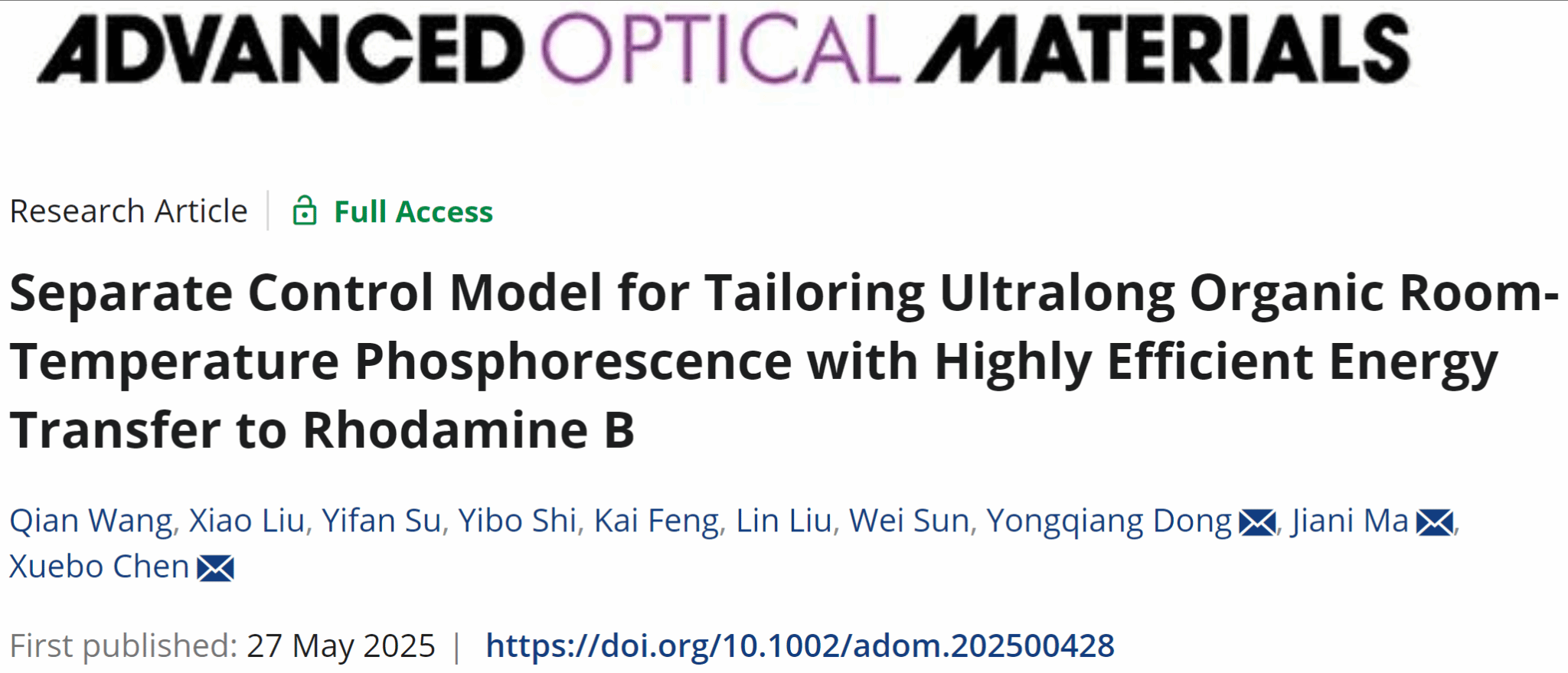
Qian Wang, Xiao Liu, Yifan Su, Yibo Shi, Kai Feng, Lin Liu, Wei Sun, Yongqiang Dong*, Jiani Ma*, Xuebo Chen*. Adv. Optical Mater. 2025, 2500428. DOI: https://doi.org/10.1002/adom.202500428

Organic room-temperature phosphorescence (RTP) materials demonstrate significant application potential in optoelectronic displays, bioimaging, and anti-counterfeiting encryption. However, achieving high-performance RTP molecules remains challenging. Larger spin-orbit coupling (SOC) values and smaller ΔEST are more prone to ISC processes, but it is difficult to achieve both simultaneously. This study proposed a “separate control model” strategy that independently optimizes SOC and ΔEST to achieve precise control over these two critical parameters. To develop efficient RTP molecules, a comprehensive dataset of donor-acceptor (D-A) structured molecules is developed using D and A fragment pools. Promising phosphorescent candidates PPTZO-CO can be efficiently identified through high-throughput screening that combines density functional theory (DFT) with high-precision multireference perturbation theory calculations.
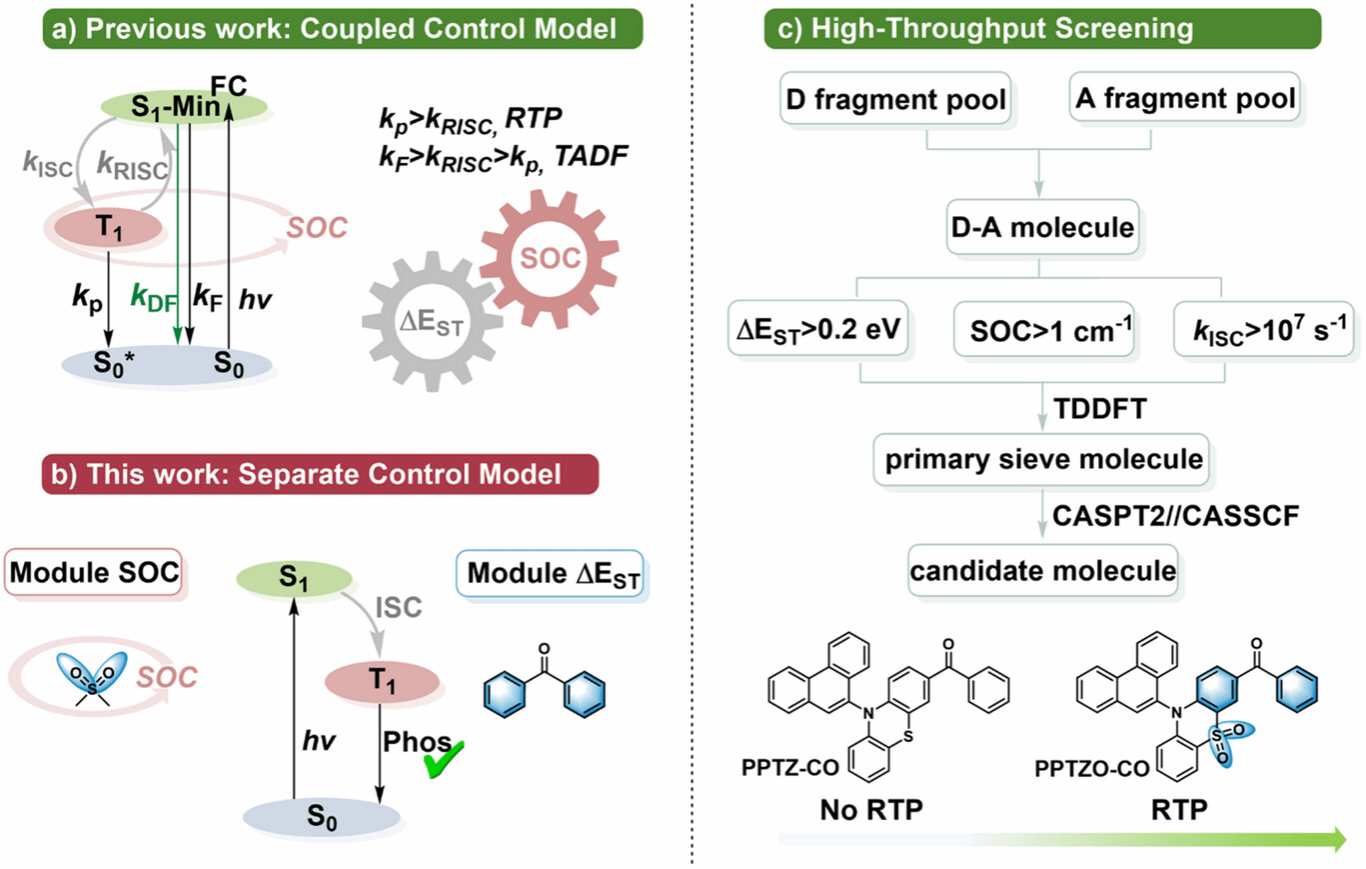
Figure 1. a) Typical coupled control model (previous work): Illustration of the conventional approach where the SOC and ΔEST are controlled simultaneously, leading to interdependent modulation of both parameters. b) Proposed separate control model strategy (this work): Diagram depicting the novel strategy employed in this study, where SOC and ΔEST are independently optimized through separate control model, allowing for more precise tuning of both parameters to achieve RTP. c) High-throughput screening process and results: Flowchart illustrating the process of high-throughput screening used to evaluate the SOC and ΔEST of various D-A molecules, leading to the identification of promising RTP candidates, including the PPTZO-CO unit. Results of the screening process are also summarized, showcasing the efficiency of the proposed strategy.
This study systematically investigated the photophysical properties of the precursor PPTZ-CO in comparison with PPTZO-CO. While PPTZO-CO exhibits RTP characteristics, PPTZ-CO demonstrates only conventional fluorescence behavior. The excitation-state dynamics of the two compounds were analyzed by femtosecond transient absorption spectroscopy (fs-TAS). Obvious intersystem crossing (ISC) processes could be observed in the PPTZO-CO film within the ps scale range. For the PPTZ-CO film, only the absorption (550 nm) and stimulated emission signal of the single excited state (S1) were observed, and no triplet state-related signals were detected, which were consistent with the characteristics of fluorescent molecules.
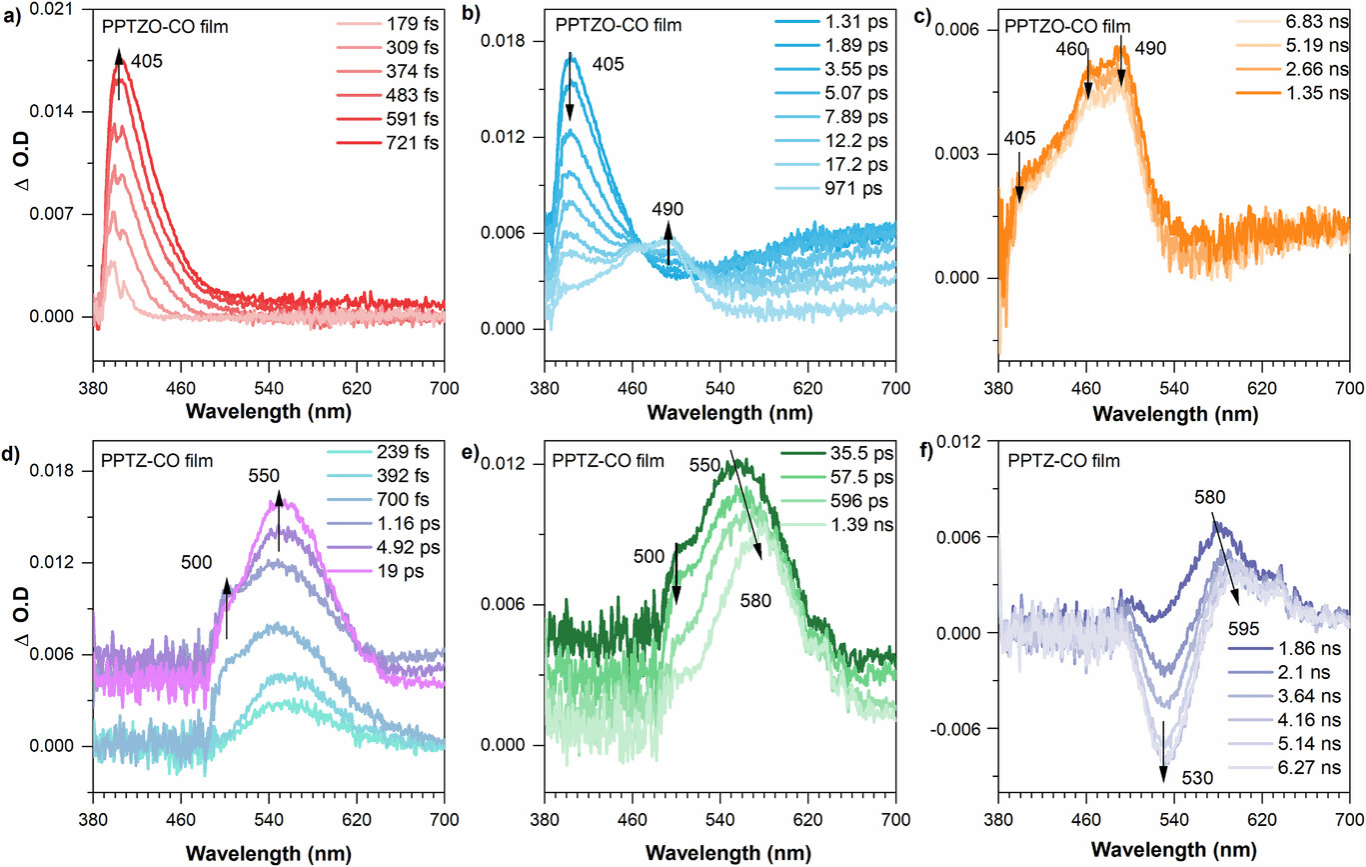
Figure 2. fs-TA spectra for thin film of a-c) PPTZO-CO and d-f) PPTZ-CO under the excitation of 330 nm at room temperature.
To gain deeper insight into the photophysical properties of PPTZ-CO and PPTZO-CO, theoretical calculations were performed using the CASPT2//CASSCF (8e,7o) method. These theoretical investigations into PPTZ-CO and PPTZO-CO reveal their distinct photophysical properties and the efficiency of their ISC processes, which are characterized by significant SOC values and rapid transition rates. The SOC of PPTZO-CO is 6 times higher than that of PPTZ-CO, accompanied by a dramatic increase in kISC from 1.4×108 s-1 to 5.6×1011 s-1, consistent with the ISC process of 6.7 ps in TAS. The steady-state and delayed spectra of PPTZ-CO and PPTZO-CO in 2-methyltetrahydrofuran solution at 77 K were measured to accurately determine the S1 and T1 energy levels. The ΔEST of PPTZ-CO and PPTZO-CO were found to be 0.38 and 0.55 eV, respectively. These findings highlight a crucial observation: despite the increase in ΔEST, there was no significant reduction in the SOC value. This observation represents the first detailed experimental confirmation of our proposed strategy, demonstrating the successful utilization of the separate control model to effectively achieve RTP.

Figure 3. Minimum-energy profiles for the a) PPTZ-CO and b) PPTZO-CO. These computational results were obtained at the CASPT2//IRC/CASSCF (8e/7o) level of theory.
When PPTZO-CO was doped into polymethyl methacrylate (PMMA), the doped systems exhibit photoactivated RTP property with long lifetime up to 700 ms. In the case of PPTZO-CO@PMMA, its phosphorescence spectrum shows a substantial overlap with the absorption spectrum of rhodamine B (RB), suggesting the potential for effective energy transfer. When 0.2% RB was incorporated into the PPTZO-CO@PMMA film, the emission exhibited only a red afterglow with energy transfer efficiency approaching 100%. Moreover, PPTZO-CO@PMMA film shows practical application potential in the field of dynamic anti-counterfeiting. It is sensitive to temperature. When heated to 120℃, it undergoes phosphorescent quenching and regains a visible green afterglow to the naked eye upon cooling. The film remains stable in luminescence in an aqueous environment and is suitable for multiple encryption anti-counterfeiting.
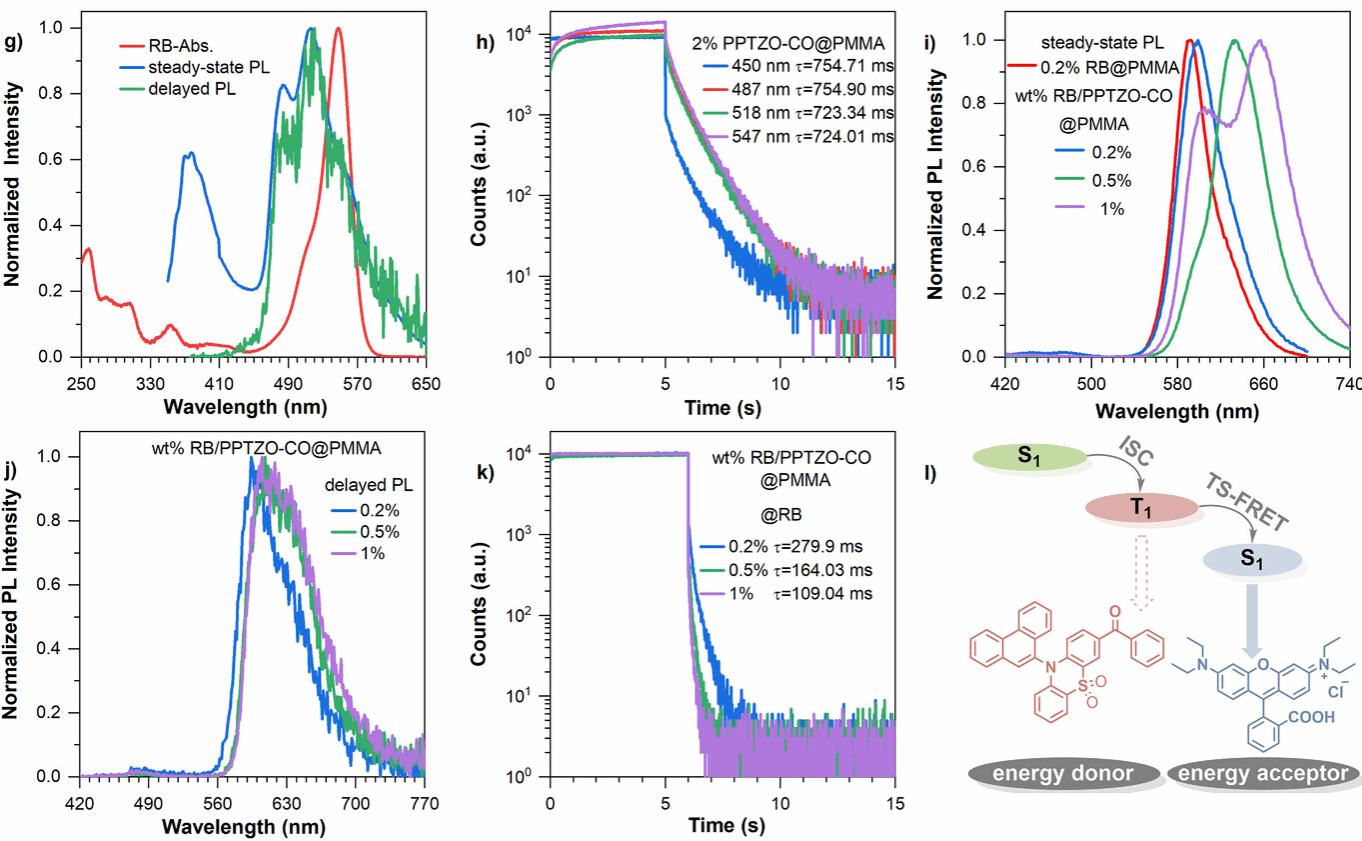
Figure 4. g) Steady-state (λex = 330 nm) and delayed PL (λex = 365 nm) spectra of 2% PPTZO-CO@PMMA, UV-vis spectrum of RB in CH3CH2OH. h) Time-resolved delayed PL decay spectra of 2% PPTZO-CO@PMMA film. i) Steady-state PL spectra of 0.2% RB@PMMA (λex = 520 nm) and wt% RB/PPTZO-CO@PMMA (λex = 365 nm). j) Delayed PL spectra of wt% RB/PPTZO-CO@PMMA (λex = 365 nm). k) Time-resolved delayed PL decay spectra of wt% RB/PPTZO-CO@PMMA film; l) Schematic diagram of RB persistent luminescence through phosphorescence resonance energy transfer. All measurements were conducted at room temperature.
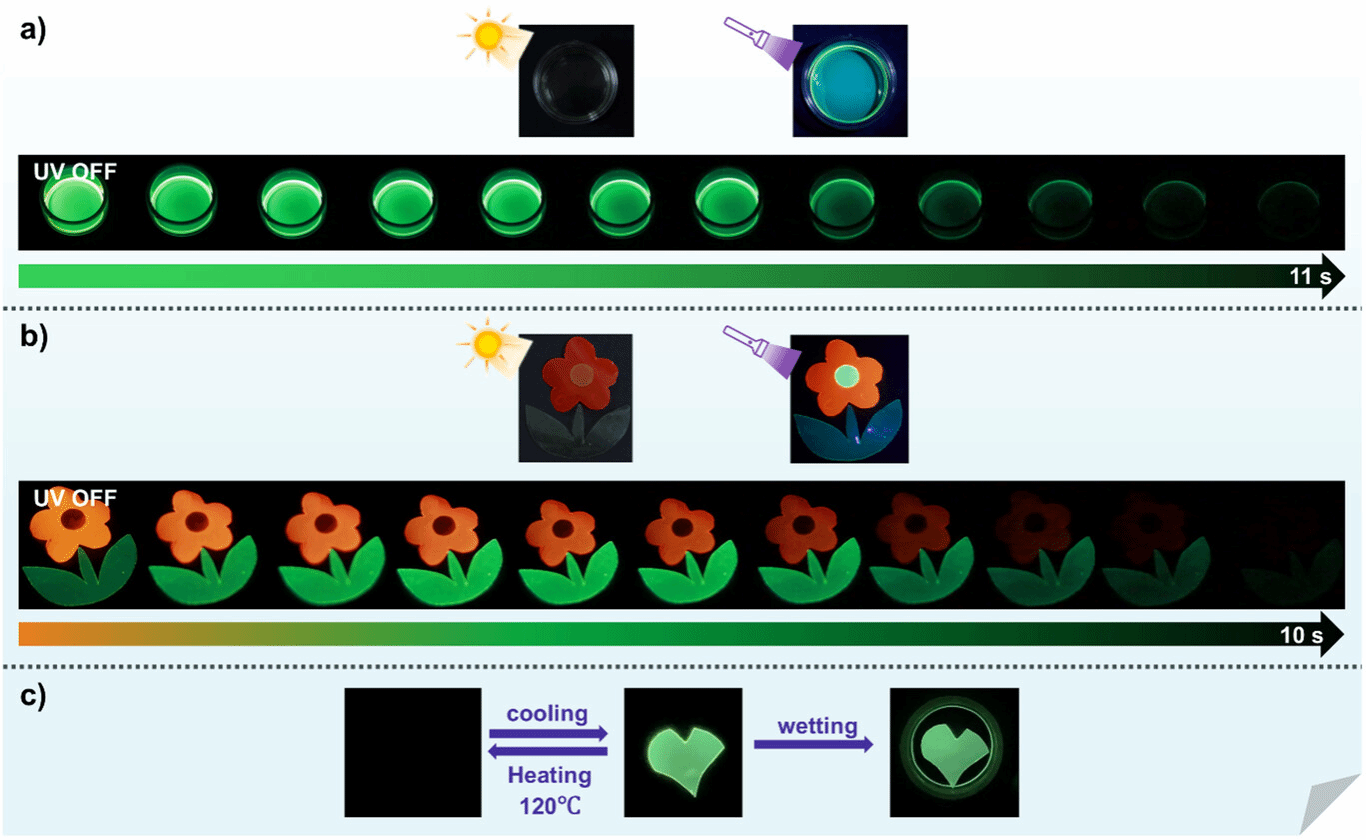
Figure 5. Potential applications of doping PMMA systems for anti-counterfeiting. a) Photographs of PPTZO-CO@PMMA in a glass petri dish at room temperature under daylight, UV on and UV-OFF state; b) Photographs of pattern of the flower, which is composed of PPTZ-CO@PMMA (stamens), 0.2% RB@PPTZO-CO@PMMA (petals), and 2% PPTZO-CO@PMMA (stipules) at room temperature under daylight, UV on and UV-OFF state, respectively; c) Reversible temperature and wetting-responsive RTP of PPTZO-CO@PMMA under UV-OFF state. The afterglow completely disappears when heated to 120 °C.
First Author: Wang Qian, doctoral candidate, Beijing Normal University
Correspondence Authors: Prof. Chen Xuebo, Prof. Dong Yongqiang, Beijing Normal University; Prof. Ma Jiani, Shaanxi Normal University
Full Text Link: https://doi.org/10.1002/adom.202500428
 Latest Updates
Latest Updates






